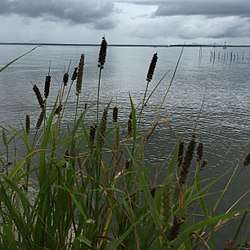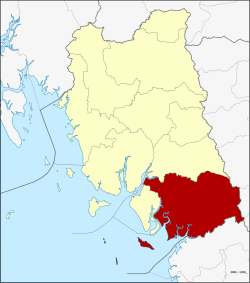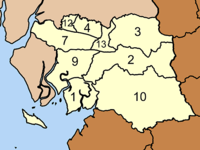Palian District
Palian District (Thai: ปะเหลียน, pronounced [pā.lǐa̯n]) is a district (amphoe) in the southern part of Trang Province, Thailand.
Palian ปะเหลียน | |
|---|---|
 Yong Star Cape | |
 District location in Trang Province | |
| Coordinates: 7°10′18″N 99°41′12″E | |
| Country | Thailand |
| Province | Trang |
| Seat | Tha Kham |
| Area | |
| • Total | 973.13 km2 (375.73 sq mi) |
| Population (2005) | |
| • Total | 62,914 |
| • Density | 64.7/km2 (168/sq mi) |
| Time zone | UTC+7 (ICT) |
| Postal code | 92120 |
| Geocode | 9204 |
Geography
Neighboring districts are (from the east clockwise) Kong Ra, Tamot, and Pa Bon of Phatthalung Province, Khuan Kalong, Manang, and Thung Wa of Satun Province, Hat Samran and Yan Ta Khao of Trang Province.
History
Originally named Yong Sata (หยงสตา) or Tan Yong Sata (ตันหยงสตา; Kelantan-Pattani Malay means 'Mango Plum Cape')[1], it was renamed Palian in 1939.[2]
Palian is believed to have been a seaport since ancient times, not less than 1,800 years ago, paired with Takola (now's Mueang Trang). When an ancient Greek merchant named Alexander sailed through here in 150, and told the story of his journey to Ptolemy recorded. At that time, Palian was called Palanda.[3]
Administration
The district is divided into 10 sub-districts (tambons), which are further subdivided into 85 villages (mubans). Tha Kham is a township (thesaban tambon) which covers parts of tambon Tha Kham. There are a further 10 tambon administrative organizations (TAO).
|
 |
Missing numbers are tambons which now form Hat Samran District.
References
- Jaisamut, Yuenyad (1996). ตรัง : เมืองท่าโบราณสองพันปี นายกรัฐมนตรีสองยุค [Trang: Two Thousand Years Ancient Trading Port, Two Periods Prime Minister] (in Thai). Bangkok: Matichon. p. 157. ISBN 9747115603.
- พระราชกฤษฎีกาเปลี่ยนนามอำเภอ กิ่งอำเภอ และตำบลบางแห่ง พุทธศักราช ๒๔๘๒ (PDF). Royal Gazette (in Thai). 56 (0 ก): 354–364. April 17, 1939.
- Chantarakiri, Rueangyot (2010-10-14). "จดหมายเหตุปโตเลมีกับสหราชอาณาจักรคีรีรัฐ" [Archives of Ptolemy and United Kingdom of Khiri Rat]. Usakanae.com (in Thai). Retrieved 2020-03-02.